When travelers discover that we specialize in travel to Hawai’i, they often first ask, “What is Hawaiian food?” You may think you’ve covered your bases if you’ve ordered a Mai Tai or snacked on pupus at a local tiki bar. However, there is much more to local food than that, whether it’s local comfort food classics like manapua or plate lunch, or better-known dishes like shave ice and poke.
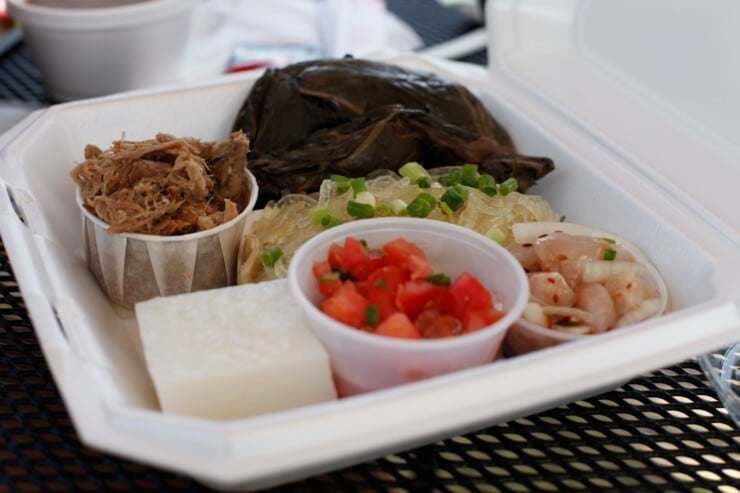
Key Takeaways
- Local food in Hawai'i is a true melting pot, blending Native Hawaiian ingredients with Japanese, Chinese, Filipino, Portuguese, and American influences.
- Must-try traditional Hawaiian foods include poke, kalua pork, laulau, and poi, which showcase the islands’ Indigenous roots and deep cultural heritage.
- Local comfort foods like loco moco, saimin, and spam musubi reflect Hawaiʻi’s plantation-era history and multicultural identity.
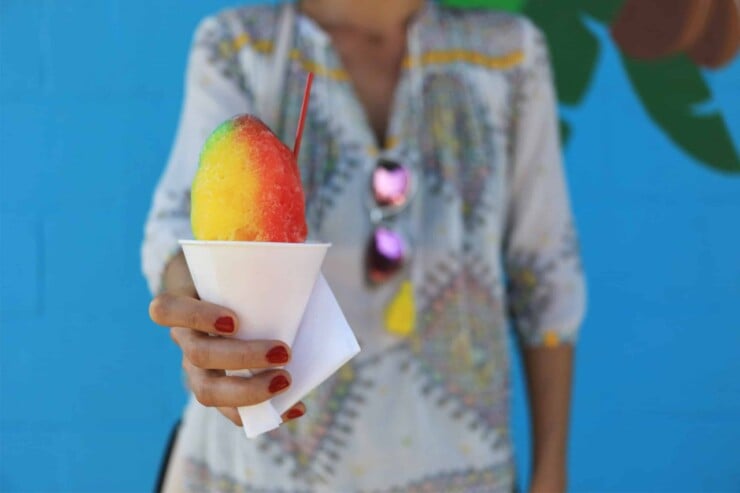
What Is Hawai’i’s Food Scene?
The food culture in Hawai’i is unique, thanks to its rich history. Starting during the Plantation Era, people arrived from diverse places, including China, Japan, the Philippines, Puerto Rico, Mexico, and Portugal. As these groups all worked together, they brought a fusion of different cultures and elements of their food traditions to the islands.
The result is that Hawai’i’s food scene has a strong fusion element. Some of the most common local dishes — such as saimin, boiled peanuts, and shoyu chicken — have flavors reminiscent of other cuisines yet are distinctly local foods. Head here to read how Hawai’i’s food scene became what it is today.
These days, there is a major focus on locally-grown food, so in everything from the farmers’ markets to high-end restaurants, you’ll notice a big focus on farm-to-table.
Add to that a creative local makers scene and renowned James Beard-nominated chefs cooking thoughtful, locally sourced food, and you have a lot of delicious food to explore when you travel to Hawai’i.

More Than 30 Local And Hawaiian Food Dishes To Try
We can, of course, help you plan a perfect Hawai’i itinerary that includes farm visits, cooking classes, tastings, market visits, and fine dining. But if you’re visiting and want to try both local comfort food and traditional dishes, we have a list of over 30 options. First, let’s explore eight traditional Hawaiian food dishes.
8 Native Hawaiian Food Dishes To Know
To be crystal clear, “Hawaiian food” or “Hawaiian cuisine” refers to food traditionally made by indigenous Hawaiians. So, if you’re talking about anything else, go ahead and refer to it as “local food” and not as “Hawaiian food.”
The traditional Hawaiian diet was based on readily available foods, including fish (i’a), octopus (he’e), sea urchin (wana), taro (kalo), sweet potatoes (‘uala), breadfruit (‘ulu), ferns (hāpuʻu ʻiʻi), kukui nuts, and seaweed.
Haupia
Haupia (pronounced “how-pea-ah”) is the classic Hawaiian dessert that you’ll likely come across the most when you visit Hawai’i. It’s traditionally made by simmering coconut milk and sugar with cornstarch, then setting it aside until it resembles a coconut pudding.
These days, haupia has also become a trendy island dessert flavor. You’ll find haupia as a shave ice flavor, combined with chocolate in a slice of pie, or even as a creamy gelato at one of our local favorites, Via Gelato in Honolulu.
Kālua Pork
Traditionally spelled kālua (pronounced “kah-loo-ah”), this is a Hawaiian cooking term meaning “to cook in an underground oven.” In Hawaii, an underground oven is called an imu (pronounced “eee-moo”), and steam is used for cooking food.
Pork is prepared this way at traditional Hawaiian luaus, one of the most popular Hawaiian dishes. Since most don’t have access to an imu, a slow cooker is a good – and despite its name — a quicker substitute.
Kulolo
Kulolo (pronounced “koo-low-low”) is a traditional Hawaiian dessert made from grated taro and coconut milk, then slow-steamed in ti leaves until sticky and chewy. Sweet and earthy with a rich texture, it’s a favorite treat often found at Hawaiian gatherings and farmers’ markets.
Laulau
This classic Polynesian dish is one that was brought to the islands by the earliest voyagers. In traditional laulau recipes, taro leaves or ti leaves are filled with fish or pork and then slow-cooked in an imu. Today, you’ll often see butterfish and pork combined, and then the mixture is steamed and served with white rice.
Lomi Lomi Salmon
This is a classic side dish in Hawaiian food that is often served at luaus alongside the other dishes listed here. It tastes as if salmon and a non-spicy pico de gallo salsa came together, as it’s a mix of raw salmon, tomatoes, scallions, and sweet Maui onions.
The term lomi-lomi (pronounced “low-mee-low-mee”) means “massage” in Hawaiian and refers to the gentle combination of the mixture before serving. To taste some of the best Hawaiian food, head to the historic spot, Haili’s Hawaiian Food, when you’re on Oahu.
Poke
Poke (pronounced “poh-kay”) is a beloved Hawaiian dish made with cubed raw fish—typically ahi tuna—seasoned simply with salt, seaweed, and roasted kukui nuts. Traditionally served as a pupu (appetizer), it reflects the islands’ deep connection to the ocean and local, fresh ingredients.
Poi
Before the sticky taro root paste (also known as kalo in Hawaiian) became a staple at lū’au buffets, poi was a staple of the Native Hawaiian diet, eaten by scooping it with your fingers into a community bowl or calabash.
Traditionally, poi is made from cooked taro root that is pounded and mashed, and it is usually served as a side dish or part of a plate lunch.
Squid Lū’au
Like laulau, this dish is found throughout Polynesia. In its simplest form, squid or octopus is slow-cooked with taro (also known as luau) and coconut milk. It’s a sweet and savory dish that’s one of our favorite traditional Hawaiian foods.
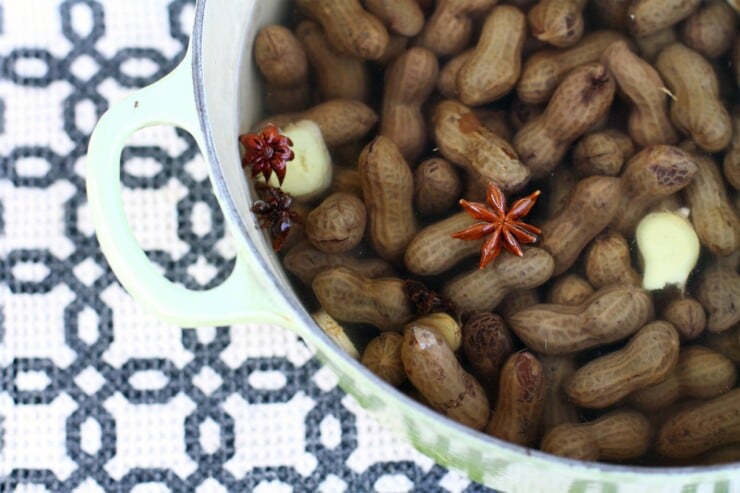
27 Hawai’i Local Foods To Try
We have a big love for local comfort foods because they are an edible slice of Hawai’i’s history. These classic local dishes are found throughout the region.
Some are found at iconic plate lunch spots, such as Tex Drive-In or Rainbow Drive-In. While others are made by home cooks for everything from University of Hawai’i football tailgates to lū’aus or casual music jam sessions and potlucks known as ‘kanikapila‘.
Banana Bread
If you’re heading to Maui, you’ll want to head out to the Road to Hana not only for the stunning views but also for the banana bread. Spots like Twin Falls Farm Stand make bread with local bananas, one of the most beloved treats you can find on the islands.
Bento
A grab-and-go lunch box inspired by Japanese tradition, Hawaiian bentos usually include rice, chicken katsu, teriyaki, SPAM, hot dog slices, tamagoyaki, and sometimes a piece of fish. These savory boxes are a staple at local convenience stores, ideal for beach days or quick lunches.
Boiled Peanuts
You might have only had boiled peanuts in the Deep South, but they’re a traditional pūpū (aka appetizer) in Hawai’i. Brought to Hawai’i by Chinese immigrants, the boiled peanuts here are typically made with generous amounts of star anise.
We often stop by local spots like Fort Ruger Market on O’ahu to get boiled peanuts and some poke before going to friends’ houses, but we also like to make our own boiled peanuts when we’re up for it!
Butter Mochi
Chicken Katsu
A local favorite, chicken katsu dish features boneless chicken cutlets breaded in panko and fried until golden and crispy. Served with rice, shredded cabbage, and a sweet-tangy katsu sauce, it’s a go-to comfort meal found in plate lunch spots across the islands.
Chicken Long Rice
Chicken Long Rice is a savory dish of shredded chicken simmered with ginger, garlic, and green onions, served over slippery glass noodles. Although it has Chinese roots, it has been embraced as a local comfort food and is a staple at Hawaiian luaus.
Coco Puffs
Like malasadas (below), Coco Puffs are among the most beloved local foods. They are similar to French profiteroles in that they are made with choux pastry, but they differ in a few distinct ways. First, they’re filled with pudding — the traditional flavor being milk chocolate.
And second, they’re topped with a mixture called chantilly. But this is not traditional French chantilly (i.e., sweetened whipped cream) but rather a sweet, slightly gritty topping made by whipping together egg yolks, sugar, and butter.
So, yes, it’s more like a buttercream frosting than chantilly, but semantics aside, it’s delicious. Liliha Bakery is credited with coming up with these sweet pastries, so make sure to try them for yourself when you visit O’ahu.
Crack Seed Store Snacks
Crack seed shops offer salty-sweet snacks that locals grew up enjoying, from dried shredded squid (ika) or arare snacks to preserved plums (li hing mui) and citrusy lemon peel. These nostalgic treats are intensely flavored and addictive, perfect for snacking or adding to drinks and desserts.
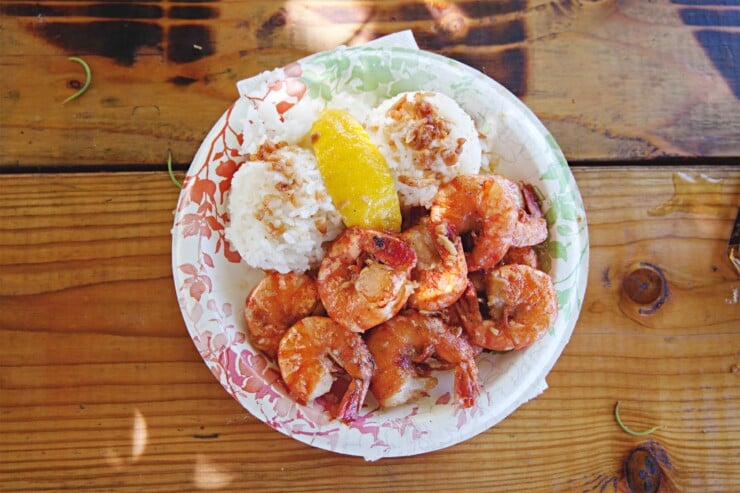
Garlic Shrimp
Garlic shrimp in Hawaii, particularly on the North Shore of Oahu, is a culinary highlight that embodies the island’s fusion of flavors. This dish, often found at numerous food trucks dotted along the scenic coastline, features large, succulent shrimp sautéed in a rich, aromatic garlic sauce.
These food trucks, such as Giovanni’s, Romy’s, and Fumi’s, have become destinations in their own right, attracting both locals and tourists. It’s a simple yet unforgettable island delicacy that combines fresh local seafood with the bold flavors of garlic, often served with rice and accompanied by a slice of lemon for an extra zing.
Huli Huli Chicken
Huli means “turning” in Hawaiian, and although huli-huli has been trademarked, it is often used to refer to a teriyaki-like, smoky-basted chicken grilled and turned rotisserie-style over kiawe (local Hawaiian mesquite) charcoal.
Whenever there is a community fundraiser in Hawai’i, you are almost guaranteed to find this slightly sweet, smoky BBQ chicken. To find some huli-huli, look for billowy smoke wafting from large grills on the side of the road. It’s sweet and tangy, with plenty of ginger, garlic, and soy — and this recipe is a simplified riff on huli huli chicken that you cook on your grill (assuming you, too, don’t own a rotisserie).
Loco Moco
This hearty, local comfort food begins with a scoop of white rice, topped with a hamburger patty (also known as a hamburger steak), brown gravy, and a fried egg. Born at Cafe 100 in Hilo in the 1940s, it’s the ultimate mash-up of diner-style flavors with a Hawai‘i twist.
Mac Nut Pancakes
Fluffy pancakes studded with toasted macadamia nuts and often served with coconut syrup or whipped butter. A breakfast classic on many local brunch menus, they’re a sweet tribute to Hawai‘i’s iconic nut.
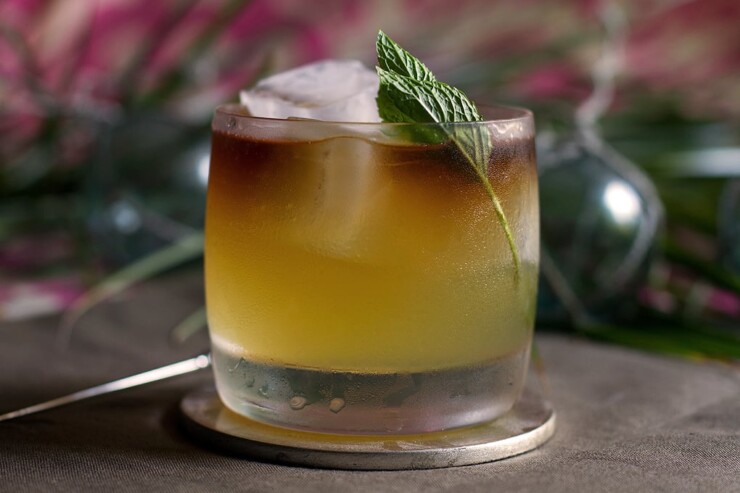
Mai Tai
While created in California, the mai tai became a symbol of tropical escape thanks to Hawai‘i’s tiki bar scene. The local version typically includes dark and light rum, pineapple and orange juice, and a splash of grenadine or orgeat.
Malasadas
Brought to Hawai’i by the Portuguese, the yeasty, airy donuts known as malasadas (pronounced “mahl-ah-sah-dahs”) are made daily at numerous bakeries across the state. Purists insist you eat malasadas plain (unfilled and sugared), but they’re often filled with local flavors like passion fruit or coconut or dipped in li hing mui (salted plum powder) sugar.
For more information about malasadas, here’s what to look for and where to find our favorites. The classic spots to get malasadas are at Leonard’s Bakery on O’ahu or at Tex Drive-In on the Big Island, though we can share a full list if you get in touch!

Manapua
The word “manapua” is a shortening of a Hawaiian phrase that translates as “delicious pork thing” — and that’s exactly what these are. Inspired by Chinese pork buns, these yeasted buns can be steamed or baked and are traditionally filled with char sui (Chinese BBQ pork) or kalua pig.
The ones pictured above are from Royal Kitchen on Oʻahu and are a must-visit spot because their manapua are always fresh and come in all sorts of flavors.
Mochiko Chicken
A local favorite, mochiko chicken is made by marinating bite-sized pieces of chicken in a sweet and savory sauce, then coating them in mochiko (sweet rice flour) and frying until crispy. The result is juicy, flavorful, and slightly chewy chicken that’s often served in bento boxes or plate lunches.
Musubi
Musubi is like a long-lost cousin to the Japanese snack known as onigiri, where sushi rice is wrapped in seaweed and often filled with all sorts of delicious flavors. But in Hawai’i, they give it a decidedly local twist with the spam musubi, where they fill sushi rice with SPAM cooked in teriyaki sauce. The classic place to get it is usually at the nearest 7-Eleven.
Pipikaula
A Hawaiian-style dried beef, pipikaula, originated as a snack for paniolo (Hawaiian cowboys). It is often marinated in soy and ginger before being dried and lightly fried. It’s chewy, salty, and packed with umami, making it a popular pupu or side dish.
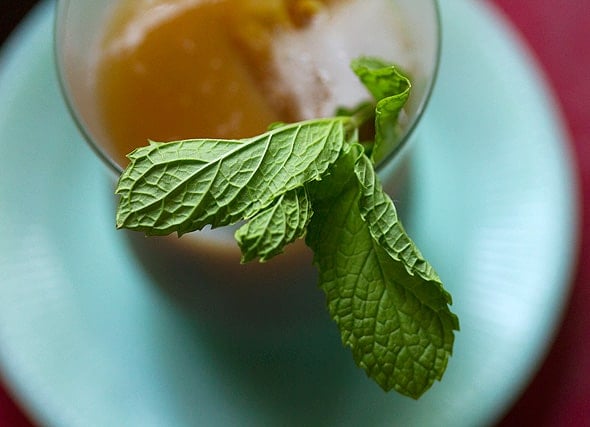
Plantation Iced Tea
Plantation Iced Tea is a refreshing Hawaiian drink made by combining black tea with pineapple juice, resulting in a balanced blend of tart, sweet, and bold flavors. Often served over ice with a slice of citrus, it’s a popular thirst-quencher that nods to Hawai‘i’s plantation era.
Plate Lunch
The quintessential local meal, a plate lunch, is said to have originated from the Japanese bento box or the Southern tradition of a meat-and-three dish. It typically includes two scoops of rice, a scoop of macaroni salad, and a hearty protein option such as teriyaki beef, kalua pig, or chicken katsu. Born from plantation-era lunch breaks, it reflects Hawai‘i’s multicultural roots and is a go-to for a satisfying, affordable meal.
POG Drink
Short for Passion Orange Guava, this juice blend is a staple in local homes, breakfast buffets, and school lunches. Sweet, tangy, and tropical, it’s a nostalgic taste of Hawai‘i in a glass.
Poke Counter Pupus
Popular pū-pū (snacks or appetizers) that you’ll find at poke counters (beyond poke) include crunchy pickled garlic and seasoned edamame, often flavored with sesame oil, chili flakes, or soy sauce. These savory bites are perfect pairings with a cold beer.
Portuguese Bean Soup
A hearty, tomato-based soup filled with smoked Portuguese sausage, beans, macaroni, cabbage, and root vegetables, Portuguese Bean Soup looks like the feijoada soup but is something all its own. This filling dish is a rainy day favorite and a legacy of Hawai‘i’s Portuguese plantation-era immigrants.
Portuguese Sausage Omelet Sandwich
A classic local breakfast features spicy, garlicky Portuguese sausage served alongside eggs and steamed white rice. At diners or local chains like Zippy’s, you might also find it in a sandwich, omelet-style, wrapped in a fluffy egg with cheese and grilled bread.
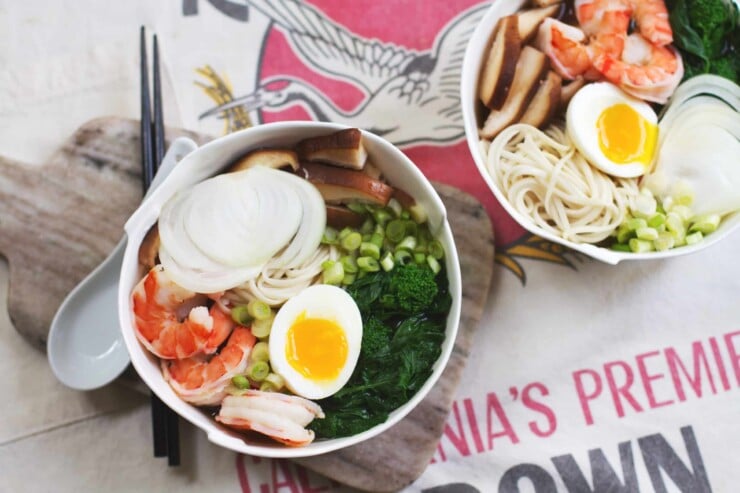
Saimin
Nearly every major ethnic group has left its mark on this ramen-like dish that hails from Hawai’i. It’s said that this soup came about thanks to the melding of cultures that happened among plantation workers. Classic saimin starts with a Japanese-like dashi broth and Chinese lo mein-like noodles. There are all sorts of toppings, from Portuguese linguica sausage to Filipino pancit and Korean kimchi. Our version of the dish is a Shrimp and Vegetable Saimin that takes some time to make but is pretty simple and very delicious.
Shave Ice
Hawaiian shave ice (not shaved ice, by the way!) is the same basic idea as a snow cone but lighter and airier because it’s made with shaved rather than crushed ice. You can find it pretty all over Hawai’i, and while traditionalists swear by Oahu’s Matsumoto or Waiola, we’re fans of Ailana because their syrups are homemade. Here is our list of where to find the best shave ice across Hawai’i.
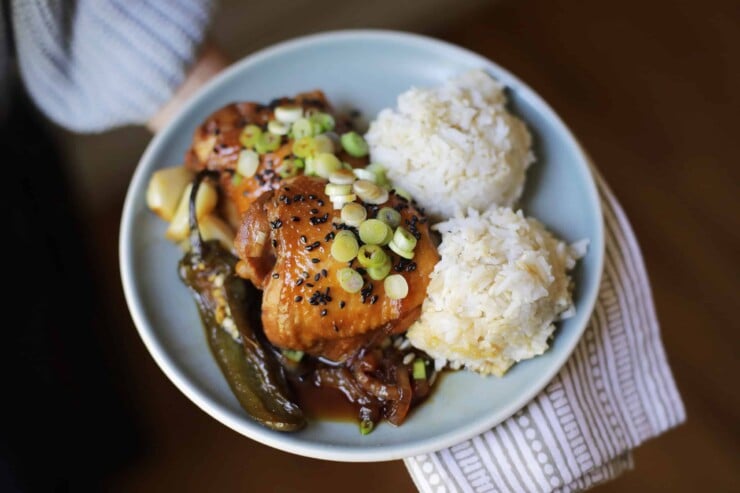
Shoyu Chicken
One of our all-time favorite local dishes is shoyu chicken. Like Portuguese Bean Soup, you might see it at a plate lunch spot, but more often, it’s found at a tailgate or during a home-cooked meal. It resembles teriyaki chicken but differs in that it’s simmered, not grilled, and served in a sauce, rather than with a glaze.
Shoyu Chicken is made by simmering chicken thighs together with shoyu and sugar, and various flavorings are most commonly ginger, garlic, and chiles. It’s a dish that’s a major crowd-pleaser, so we often make it around here as a weeknight meal.
Get A Personalized Travel Itinerary
Frequently Asked Questions About Hawaiian Food
Hawaii does indeed have traditional food that the native Hawaiian people ate. Traditional Hawaiian food dishes include poi, laulau, lomi lomi salmon, squid luau, kalua pig, and haupia.
Some famous local foods in Hawaii include Poke, Kalua Pig, Loco Moco, Spam Musubi, Saimin, Haupia, and Shave Ice. These dishes are iconic in Hawaiian cuisine, offering a taste of the local flavors and culinary traditions.
Yes, traditional Hawaiian food can be found on all the Hawaiian Islands, though you may need to search it out if you are staying in a resort. Each island has its unique spots where you can enjoy authentic Hawaiian dishes, from casual eateries to fine dining restaurants, including classic spots like Haili's and Rainbow Drive-In on Oahu.
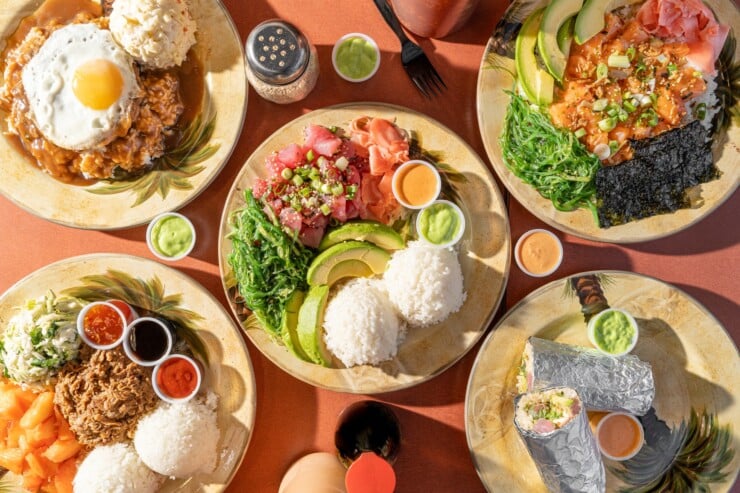
Where To Eat In Hawai’i
Now that you know about local and Hawaiian food, you may wonder where to eat while visiting Hawai’i. We have our pick of Kauai’s best restaurants and the top places to eat in Oahu’s Waikiki, from casual spots like Musuubi Cafe Iyasume to fine dining options.
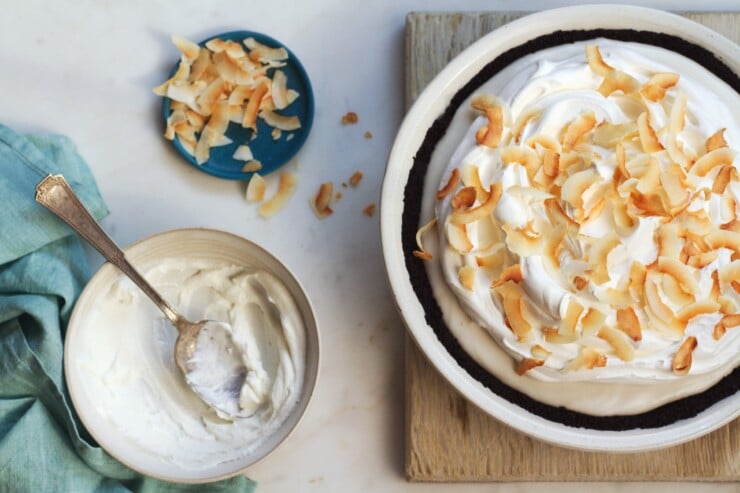
Recipes Inspired By Hawai’i
Not heading to Hawaii quite yet? Here are a few of our favorite local Hawaiian recipes to make at home to stoke your wanderlust:
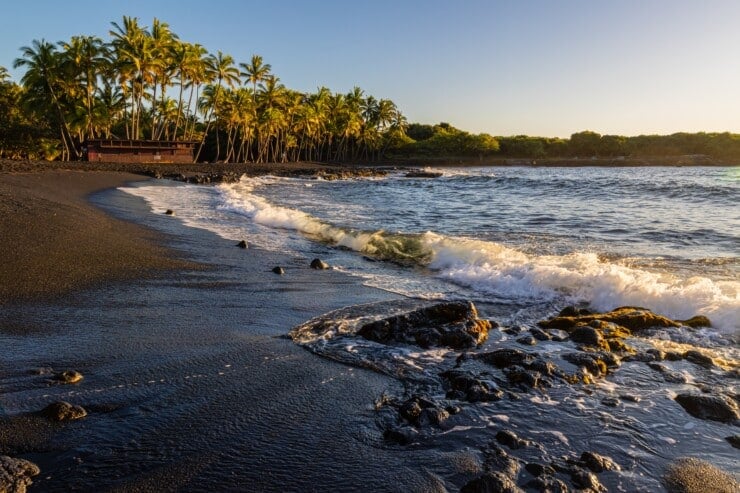
Hawai’i Travel Guide
Looking to travel to the Aloha state soon? Check out our Hawai’i travel guide with tips for where to eat, where to stay, and what to do across the islands.
Have Us Plan Your Hawai’i Trip
Did you know that we’re also a boutique travel agency specializing in Hawai’i vacation planning? If you’re looking to plan a trip to Hawai’i, our Hawai’i trip planner services are here to help you plan your perfect itinerary.
Hawaiian Diacritical Marks: To ensure accuracy and respect for the Hawaiian language, we use diacritical marks in our articles on the region. For more about which marks are used in the language and how to find proper spelling, refer to this Hawai’i Magazine article.
8 thoughts on “More Than 30 Local and Hawaiian Food Dishes To Try”
This is a great list of local foods to try in Hawai’i! I’m excited to try some of them!
This is a great list of local foods to try in Hawai’i! I’m excited to try some of them!
This is a great list of local foods to try in Hawai’i! I’m excited to try some of them!
This is a great list of local foods to try in Hawai’i! I’m excited to try some of them!
This is a great list of local foods to try in Hawai’i! I’m excited to try some of them!
OMG, I can’t wait to try all of these local foods when I visit Hawaii! The posterenini is calling my name 😍
I loved this post! It’s amazing to see such a wide variety of delicious local foods in Hawaii. I can’t wait to try poke and loco moco on my next visit. Thanks for sharing these tasty insights!
This list is amazing! I never realized how diverse Hawaiian cuisine is. I can’t wait to try loco moco and shave ice on my next trip. Thanks for sharing these delicious recommendations!